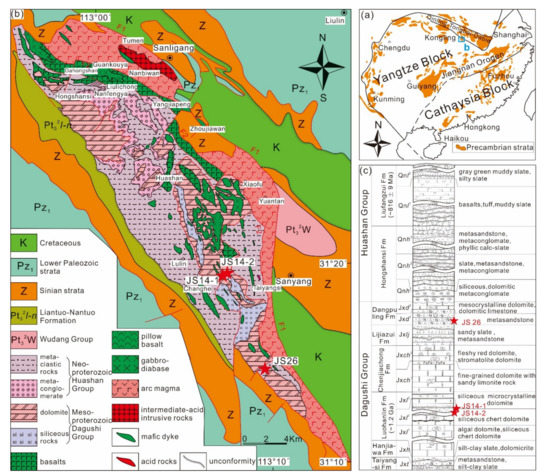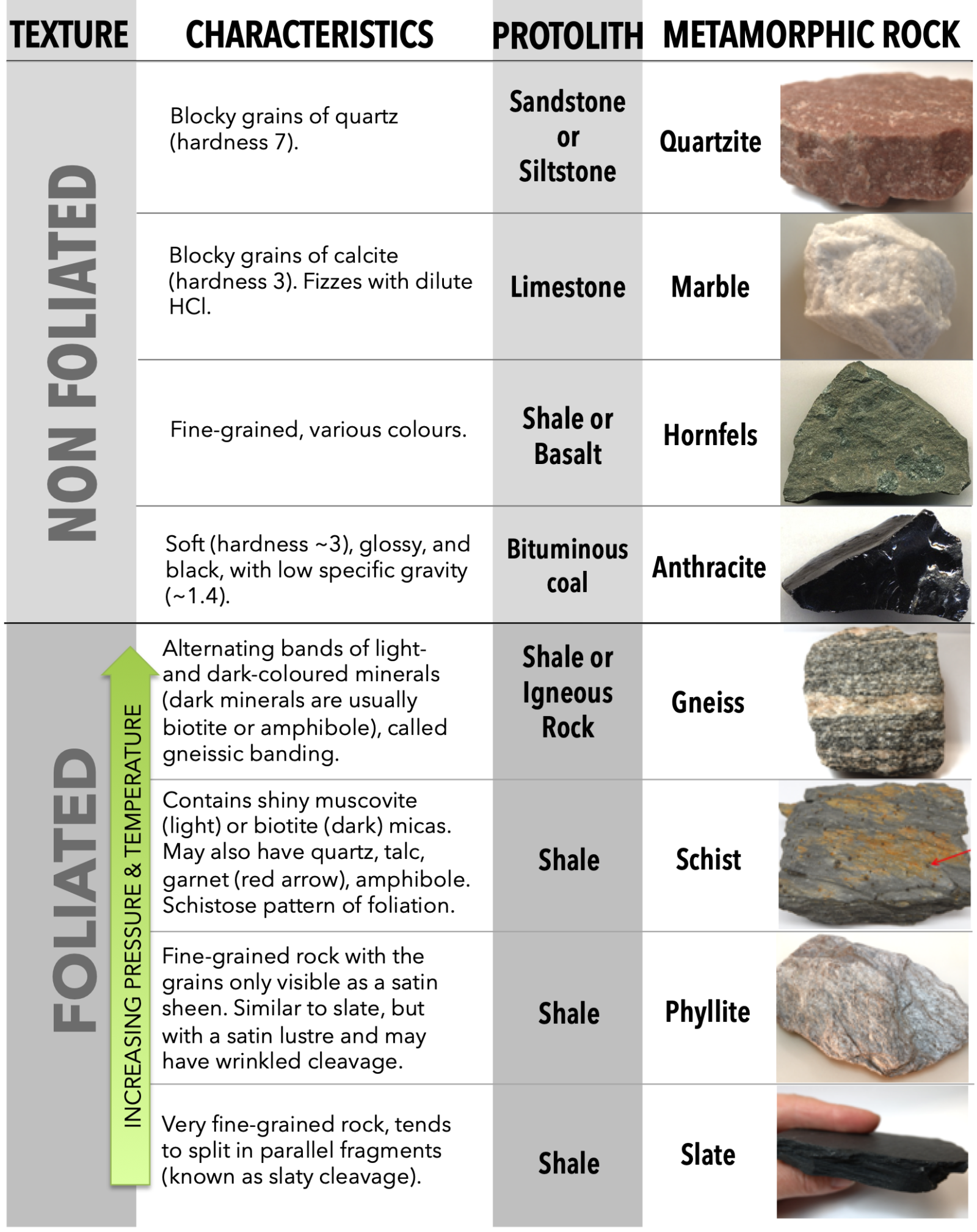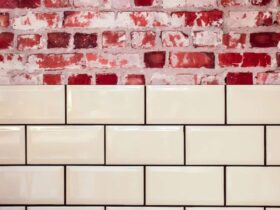The protolith of slate is shale, a sedimentary rock composed of small particles like silt and clay, which undergoes intense heat and pressure to transform into slate, a dense metamorphic rock that maintains a layered or foliated texture. Slate is a fascinating rock as it has been used for various purposes, including flooring, roofing, and even writing slates in the past.
With its smooth surface and ability to split into thin, flat pieces, slate has unique properties that make it popular in construction and decorative industries. Despite its popularity, many people may not know much about the origin of this rock.
We will explore the protolith of slate, which is vital in understanding the formation and characteristics of this fascinating rock.
What Is The Protolith Of Slate?
The protolith of slate is shale, a sedimentary rock composed primarily of small particles like silt and clay. After undergoing intense heat and pressure, shales are transformed into dense slate, which maintains a layered or foliated texture. To differentiate visually between shale and slate, observe their differences in color, texture, fossil content, and how they split or break.
Introduction
Slate is a type of metamorphic rock that forms through the process of intense heat and pressure on the original rock, called the protolith. Understanding the protolith of slate is crucial to understanding the formation of this unique and popular rock. In this blog post, we will explore the definition, composition, and properties of the protolith of slate.
Definition Of Protolith
The term protolith refers to the original rock that undergoes metamorphism to form a new rock. In the case of slate, the protolith is shale, a type of sedimentary rock that is composed primarily of small particles such as silt and clay. Shale itself is a layered mudstone that has a laminated structure comprising of fine, flat, thin layers. These layers easily split apart, forming clefts or fissures.
Composition Of Protolith Of Slate
The composition of the protolith of slate is predominantly clay minerals, including illite and smectite. The clay minerals are usually deposited in a marine environment, where the rate of sedimentation is high, and the water is rich in suspended particles. Over time, sediments accumulate and are buried under more sediments, causing the temperature and pressure to increase. This increase in heat and pressure causes the protolith to undergo metamorphism and transforms into slate.
The exact composition and properties of slate are dependent upon a variety of factors, including the chemical composition of the protolith, the temperature and pressure during metamorphism, and the length of time the rock was subjected to these conditions.
Conclusion
The protolith of slate is shale, a type of sedimentary rock composed of small particles such as silt and clay. The transformation of shale into slate occurs due to intense heat and pressure during metamorphism, resulting in the formation of a dense, smooth, foliated rock. Understanding the composition and properties of the protolith of slate helps us understand the unique characteristics of this popular rock.

Credit: www.researchgate.net
Uncovering The Origin Of Protolith Of Slate
Slate is a metamorphic rock formed from a sedimentary rock called shale. The original rock, or protolith, underwent intense heat and pressure, resulting in the formation of slate. Slate maintains a layered texture and can be differentiated from shale by its smooth surface and ability to split into thin, flat pieces.
Uncovering the Origin of Protolith of Slate
Slate is a fine-grained metamorphic rock with a layered or foliated texture, which makes it ideal for roofing and flooring. But what is the protolith of slate? The protolith refers to the original rock that undergoes metamorphosis to become slate. In this article, we will take a closer look at the origin of protolith of slate, the sedimentary to metamorphic process, and the parent rock of slate.
Sedimentary To Metamorphic Process
The process of transforming a sedimentary rock into a metamorphic rock involves intense heat and pressure. In the case of slate, the protolith is shale, which is a layered mudstone composed of fine particles of silt and clay. When shale is subjected to heat and pressure, the minerals in the rock begin to reorganize, forming new structures and textures. This process transforms shale into slate, which is a much denser rock with a foliated texture.
Parent Rock Of Slate
The parent rock of slate is mudstone or mud, which is a type of sedimentary rock. Mudstone forms from the lithification of mud, which occurs due to burial under sediment. Under the extreme heat and pressure of metamorphism, mudstone transforms into slate, which is known for its fine-grained texture and characteristic foliation. The parent rock of slate is an important factor in determining the geological history of a region, and mining of slate is an important industry in certain parts of the world.
Determining The Protolith
Determining the protolith of slate can be a challenging task, as the original rock may have undergone multiple stages of metamorphism. Geologists use various techniques to identify the protolith of slate, including petrographic analysis, X-ray diffraction, and mineral identification. These methods help to determine the mineralogy, chemistry, and texture of the rock, which in turn aids in identifying the protolith of slate.
In conclusion, slate is a popular metamorphic rock with a unique texture that is ideal for construction and design purposes. Understanding the origin of protolith of slate can provide valuable insights into the geological history of a region. By examining the sedimentary to metamorphic process, the parent rock of slate, and the methods for determining the protolith, we can gain a better understanding of this fascinating material.
Characteristics Of Slate
The protolith of slate is shale, a sedimentary rock composed of small particles like silt and clay. Undergoing intense heat and pressure, shales transform into dense slate while maintaining a layered or foliated texture. Shale and slate can be visually differentiated by their color, texture, fossil content, and how they split or break.
fine-grained metamorphic rock, has unique characteristics that distinguish it from shale. In this section, we will focus on the characteristics of slate, including color, texture, and fissility, and provide a deeper understanding of the protolith of slate.
Color
Slate has distinctive coloration that varies depending on the type of minerals present during its formation. Typically, slate has a dark gray or charcoal color, but it can also range from purple and blue to greenish-gray and black. In some instances, slate may have distinct color variations and markings that make it more aesthetically pleasing and desirable for decorative purposes.
Texture
Texture is one of the most recognizable characteristics of slate. When examining slate, you will notice that it has a fine-grained, smooth texture that feels similar to a chalkboard or soapstone. The surface of slate is generally flat and polished, which makes it an excellent material for roofing, flooring, and other construction applications.
Fissility
Fissility is the ability of a rock to split along layers and form thin, flat sheets. Slate is well-known for its outstanding fissility, and it is the result of the pressure and heat that the protolith of slate (shale) underwent during metamorphism. As a result, slate can be easily split into sheets that can be applied to roofing, flooring, and other surfaces.
In conclusion, the protolith of slate is shale, a sedimentary rock that has undergone intense heat and pressure, resulting in a fine-grained metamorphic rock with distinctive characteristics. The color, texture and fissility of slate make it a popular material in the construction industry and in decorative applications. Knowing these characteristics is essential for selecting the right kind of slate for your building or home renovation project.

Credit: www.studypool.com
Uses Of Slate
The protolith of slate, a fine-grained foliated metamorphic rock, is shale. Shale, a layered mudstone composed of silt and clay, undergoes intense heat and pressure to transform into slate, maintaining its layered or foliated texture. One can visually differentiate between shale and slate based on their color, texture, fossil content, and how they split or break.
c rock composed of fine-grained minerals, is usually darker and has a smooth surface that can be easily split into thin, flat pieces. Now that we know what slate is and what its protolith is, let’s dive deeper into the topic with a look at the uses of slate.
Historical Use
Slate has been used for centuries as a roofing material due to its durability, resistance to weathering, and fire retardant qualities. It was also used as a building material for flooring, countertops, and even as a chalkboard surface. The ancient Romans were known to use slate for writing tablets, and it was commonly used for writing surfaces in schools until replaced by modern whiteboards. In the early 1800s, slate was used for billiard tables due to its ability to hold a flat and smooth surface.
Modern Applications
In modern times, slate is still used in construction for roofing, flooring, and countertops. It is also used as a decorative material for landscaping, wall cladding, and even as a material for outdoor furniture. Due to its water resistance and non-slip surface, it is a popular choice for swimming pool surrounds and pathways. Slate is also a popular crafting material for making coasters, cheese boards, and other decorative household items.
In conclusion, the uses of slate are varied and have a rich history dating back centuries. Whether used for building, crafting, or decoration, slate continues to be a popular choice for its durability, aesthetics, and versatility.
Comparison With Other Rocks
The protolith of slate, a fine-grained metamorphic rock, is shale – a sedimentary rock primarily composed of silt and clay particles. Under intense heat and pressure, shale transforms into slate, maintaining a layered texture. Visually, slate has a smooth surface and splits into thin, flat pieces, while shale appears dull, muddy, and fossil-rich, with uneven fractures.
e other hand, slate is a metamorphic rock that has undergone significant heat and pressure, resulting in a smooth, flat surface that easily splits into thin pieces.
Now, let’s dive into a comparison of slate with other rocks.
Slate Vs Shale
Slate and shale have very similar properties since shale is the protolith of slate. However, there are some differences that set them apart.
One primary difference is their texture. Shale is a layered mudstone, composed primarily of small particles such as silt and clay, while slate is much denser since it has undergone metamorphosis due to intense heat and pressure.
Another difference is their splitting properties. Shale fractures unevenly and does not break off in smooth sheets, whereas slate has a smooth surface and easily splits into thin, flat pieces.
Slate Vs Phyllite
While slate and phyllite are both metamorphic rocks, there are some significant differences between them.
Phyllite is formed as a result of more extreme pressure and heat than slate. As a result, it has a higher degree of metamorphism, and its foliation is more pronounced than slate.
Additionally, phyllite has shiny surfaces due to mica minerals present in it, whereas slate has a smooth, matte surface without any mica.
Slate Vs Schist
Slate and schist have visible differences in their appearance and properties. Schist is formed from more significant heat and pressure than slate, and therefore, is more metamorphosed.
Schist has visible mineral crystals, such as mica, visible with the naked eye, which slate lacks. Also, schist has a distinct foliation pattern that sets it apart from slate.
In summary, slate is a unique and beautiful rock with distinct properties, differentiating it from other rocks like shale, phyllite, and schist. Understanding the comparison with other rocks can provide insights into the geological processes responsible for the formation of slate.

Credit: www.mdpi.com
Frequently Asked Questions On What Is The Protolith Of Slate
What Is The Parents Rock Of Slate?
The protolith of slate is shale, a sedimentary rock composed mainly of silt and clay. Undergoing intense heat and pressure, shales transform into dense slate, maintaining a layered or foliated texture. Visually, slate appears smooth and splits into thin, flat pieces, while shale appears dull, muddy, and fossil-rich, fracturing unevenly.
To differentiate between shale and slate, one can observe their properties such as color, texture, fossils, and the way they split or break.
Which Is A Protolith Of Quartzite?
The protolith of quartzite is sandstone. Sandstone undergoes intense heat and pressure, causing cemented sand grains to recrystallize into quartzite.
What Rock Is Protolith?
The protolith of slate is a sedimentary rock called shale. It transforms into dense slate through intense heat and pressure while maintaining a layered or foliated texture. Shales are comprised mainly of small particles like silt and clay.
What Rock Turns Into Slate?
Protolith of slate is shale, a sedimentary rock composed of small particles such as silt and clay. Undergoing intense heat and pressure, shale is transformed into dense slate, which maintains a layered or foliated texture.
What Is A Protolith In Relation To Slate?
A protolith is the original rock that slate metamorphosed from. In the case of slate, the protolith is shale.
Conclusion
The protolith of slate is shale, a sedimentary rock composed of small particles such as silt and clay. Undergoing intense heat and pressure, shale transforms into fine-grained slate maintaining a layered or foliated texture. Mudstone is the parent rock of slate, which lithifies due to burial becoming mudstone and then under metamorphism becomes slate.
It is important to visually differentiate between shale and slate by observing their properties such as color, texture, fossils, and the way they split or fracture. Knowing its protolith helps to understand the formation and characteristics of slate.









Leave a Reply